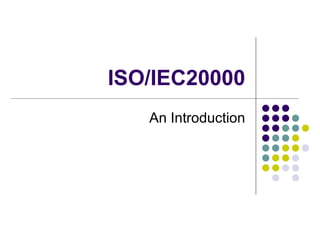ISO/I20000 in a nutshell
- 2. In a Nutshell International standard for IT Management Shift from technology to services Integrated process approach Requires strong commitment and effort from all levels Focused on continual improvement Effective delivery of services to the business and its customers Built on the ITIL best practice methodology A formal specification that defines the requirements
- 3. Why ISO/IEC20000? ŌĆ£ [ISO/IEC 20000] provides a baseline against which the internal IS organisation can demonstrate to the business that itŌĆÖs service processes represent Best practice and are performing wellŌĆØ. Simon Mingay, Research VP Gartner
- 4. Why ISO/IEC20000? Key business drivers of ISO/IEC 20000 are to reinforce and provide formal accreditation based on internationally adopted ITIL best practice guidelines and provide a formal and auditable standard for the delivery of IT services within an organisation. ISO/IEC 20000 certification allows companies to demonstrate a real commitment to IT quality, and by being ISO/IEC 20000 certified a company can show that they do not just pay lip service to the statement ŌĆśITIL CompliantŌĆÖ but that they are truly ITIL compliant.
- 5. What is it used for? It may be used by businesses that are going out to tender for their services To provide a consistent approach by all service providers in a supply chain To benchmark IT service management As the basis for an independent assessment To demonstrate the ability to meet customer requirements to improve services
- 6. Benefits Is the de-jure quality standard for IT Service Management An externally verified stamp of IT Best Practice that is achievable and affordable. ISO/IEC 20000 is: the international, minimum level of a cceptable operational performance a light-weight approach to implementing ITIL E.g. Capacity Management has 7 requirements that need to be met Just enough coordination so that you donŌĆÖt trip yourself up Provides direction, enforces discipline concerned with Capability rather than Maturity ŌĆ£ Do you do this?ŌĆØ rather than ŌĆ£How well do you do it?ŌĆØ Capability ’āĀ learn to walk. Start with what you have. Get it right as a manual process if needs be.
- 7. Benefits ISO/IEC 20000 is (cont.): Focussed on getting Continual Improvement established This is a Core Engine to keep driving self-generated, bespoke value for your organisation over time ŌĆ£ The gift that keeps on givingŌĆ”ŌĆØ internal development of appropriate levels of maturity over the long term Not dependent on toolsets or automation Tools are part of improved Maturity Levels ’āĀ when you can walk (have proven Capability) then move from ŌĆśspreadsheetsŌĆÖ to fully automated, integrated, measured optimisation ITIL / COBIT are a body of knowledge for Industry Best Practice Never intended to be fully implemented Provide Guidance and insight Not a Standard - Standards can be audited & certified for international recognition (ISO27000, CMMi)
- 8. A Brief History 2000: The CCTA merged into the OGC, Office for Government Commerce (UK). In the same year, Microsoft used ITIL as the basis to develop their proprietary Microsoft Operations Framework (MOF). In addition, the worlds first ITIL aligned standard is published by BSI (British Standards Institute): BS15000. 2001: In 2001, version 2 of ITIL was released. The Service Support and Service Delivery books were redeveloped into more concise usable volumes. 2002: The BS15000 service management standard is significantly revised. International adoption spreads 2005: Consultation for a new released of ITIL itself is undertaken. BS15000 is placed under 'fast track' to become an ISO standard ISO 20000 due to large international demand 2007: ITIL v3 published. ISO20000 Edition 2 underway, new parts are being drafted e.g. an exemplar will be published as Part 4. Plans to align ISO20000 to ITIL V3 have been discussed; Edition 2 will not address this issue.
- 9. About me Qualified ISO/IEC 20000 Consultant Experienced in helping IT departments achieve ISO20000 certification 14+ years experience in the IT industry with full-lifecycle experience CobiT ┬« , CMMI, ITIL ┬« , ISO/IEC 20000, PRINCE2 IŌĆÖve been in the position of slogging my way through endless outages, poor system performance and frustrated customers. Best practice methodologies like ITIL provided structure and hard-won wisdom that elevated my support and development efforts to an efficient and maintainable level with tangible improvements. I can help you to bring these same benefits to your organisation. Contact Details References and CV: http:// www.linkedin.com/in/carolinemouton Skype: caroline.mouton1



![Why ISO/IEC20000? ŌĆ£ [ISO/IEC 20000] provides a baseline against which the internal IS organisation can demonstrate to the business that itŌĆÖs service processes represent Best practice and are performing wellŌĆØ. Simon Mingay, Research VP Gartner](https://image.slidesharecdn.com/iso20kinanutshell-100507103324-phpapp02/85/ISO-I20000-in-a-nutshell-3-320.jpg)





